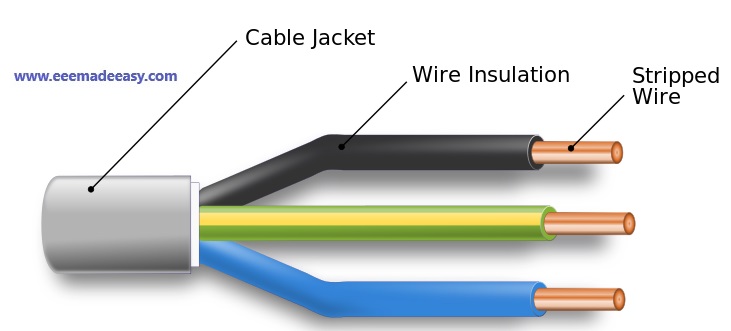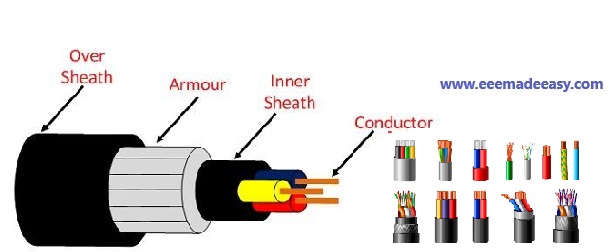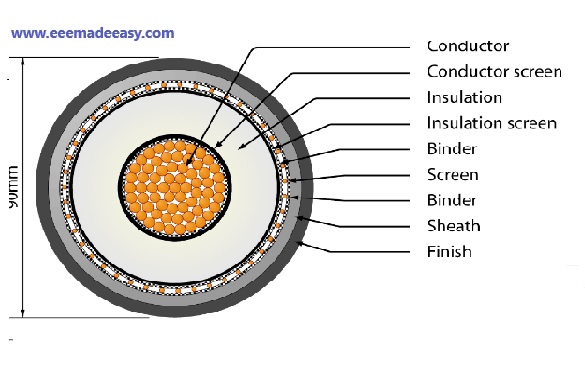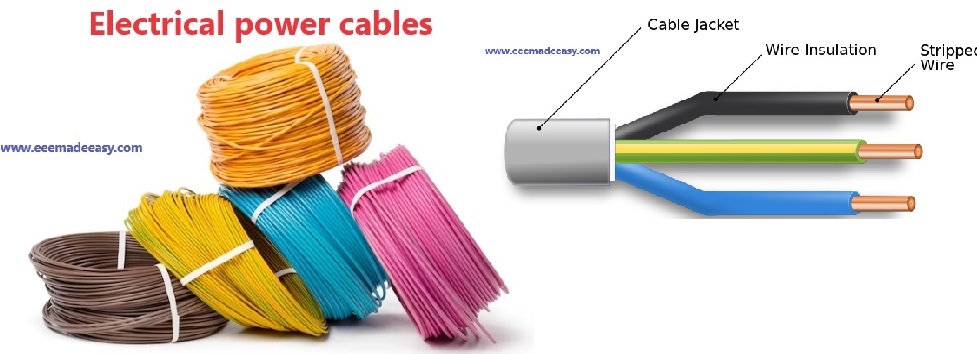Electrical power cable: Power cables are mainly used for power transmission & distribution purposes. It is an assembly of one or more individually insulated electrical conductors, usually held together with an overall sheath.
Electrical power cables may be installed as permanent wiring within buildings, buried in the ground and run overhead or exposed.
Flexible power cables are used for portable devices, mobile tools and machinery.
Read : [PDF]IE Rules|Indian Electricity Rules 1956

Construction of Power Cable
There are various parts of a cable to be taken care of during construction. The power cable mainly consists of
- CONDUCTOR
- INSULATION
- LAY for Multicore cables only
- BEDDING
- BRAIDING/ARMOURING (IF REQUIRED)
- OUTER SHEATH

CONDUCTOR
Conductors are the only power carrying path in a power cable. Conductors are of different materials.
Mainly in cable industry we use copper (ATC, ABC) and aluminium conductors for power cables.
There are different types of conductor as
Class 1: solid,
Class 2 stranded,
Class 5 flexible,
Class 6 Extra flexible (Mostly used for cords & welding) etc.
Conductor sizes are identified with conductor resistance.

INSULATION
The insulation provided on each conductor of a cable by mainly PVC (POLY VINYL CLORIDE ), XLPE (CROSSLINKED POLYETHYELENE), RUBBER (VARIUS TYPES OF RUBBER ). Insulating material is based on operating temperature.
Cores are identified by colour coding by using different colours on insulation or by number printing on cores
BEDDING (INNER SHEATH)
This portion of the cable is also known as inner sheath.
Mostly it is used in Multi core cables. It works as binder for insulated conductors together in multi-core power cables and provides bedding to armour/braid.
This portion of the cable is mainly made of PVC( PVC ST-1, PVC ST-2 ), RUBBER (CSP SE-3, CSP SE-4 & PCP SE-3, PCP SE-4, HOFR SE-3 HOFR SE-4, HD HOFR SE-3 ETC)
ARMOURING
There are mainly
- G.I. WIRE ARMOURING
- G.I. STEEL STRIP armouring.
It is done by placing G.I. WIREs, GI or STEEL STRIPs one by one on inner sheath.
Armouring is a process which is done mainly for providing earthing shield to the current carrying conductors as well as it is also used for earthing purpose of the cable for safety.
When there is any insulation failure in the conductor, the fault current gets enough paths to flow through the armour if it is properly earthed.
Providing extra mechanical protection and strength to cable an important added advantage of armouring. In MINING CABLES it is done for conductance
BRAIDING
ANNEALED TINNED COPPER WIRE , NYLON BRAID , COTTON BRAID are mainly used for this purpose.
Braiding is the process which gives high mechanical protection to cable and also used for earthing purpose. Significance of braiding is it is more flexible in comparison to armouring.
OUTER SHEATH
This is outermost cover of the cable normally made of PVC (POLYVINYL CLORIDE ), RUBBER (VARIUS TYPES OF RUBBER) and often the same material as the bedding.
It is provided over the armour for overall mechanical, weather, chemical and electrical protection.
Outer sheath is protection offered to cable not much electrically but more mechanically.
Latest Posts in EEE Made Easy
- Environment MCQ for RRB JE CBT 2|Objective Questions Environment for Competitive Exams
- RRB JE CBT 2 Computer Awareness Book Arihant|Objective Computer Awareness Book 2025
- RRB JE CBT 2 Exam Date 2025 Postponed|RRB JE CBT 2 Exam Date
- [PDF]RRB JE Result 03/2024 Cut off, Selected no of candidates for all regions
- [PDF]Final Answer Key Junior Instructor Mechanic Agricultural Machinery|643/2023 Solved Question paper
- Acoustics MCQs|Industries Extension officer|IEO 2025
- LASER MCQs| Industries Extension officer|IEO 2025




